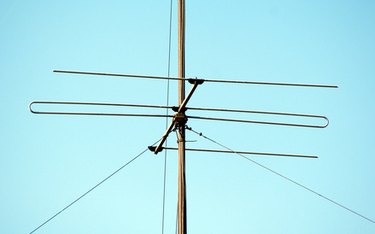
Television broadcast reception, as well as radio, is incredibly sensitive to obstacles (buildings, large trees, etc.) and requires precise tuning -- far more than most indoor VHF or UHF antennas can provide. Using a TV or radio antenna indoors will seldom lead to good reception. But a reliable outside tower can be made from an individual piece of aluminum or steel pipe, secured to your rooftop or to the side of your residence. An antenna can then be placed at the top of the tower, clear from the interference of trees or other obstacles. A free-of-charge service at antennaweb.org will then help you determine the direction in which you should point your antenna to get the best TV and radio broadcast signals.
Preparation
Video of the Day
Step 1
Decide on the best location and elevation for the tower, whether braced against the side of your home or mounted on the rooftop. To orient your antenna to pick up the best signals, a router is highly recommended. With a motor-driven router mounted at the base of the antenna, you'll easily be able to rotate the antenna until it's lined up for the best-possible signal. Without a router, you'll have to manually rotate the antenna until you find one signal, and then manually re-adjust the antenna's position every time you want to find a new broadcast signal.
Video of the Day
Step 2
To determine the right height for your tower, measure the distance from the top of your roof to ground level. If your antenna will be braced against your home and facing away from your property, measure up toward the roof and add three feet to provide you with ample distance for installing the antenna tower. If your residence has multiple roof gables, be sure to measure the distance to the roof's tallest peak.
Step 3
Add three feet to the height of your tower structure if the roof has an overhang, or if other obstructions (window casings, delicate brickwork, etc.) prevent you from securing the tower platform directly to the side of your house. If you're able to secure the tower structure to your home, add another foot to its overall height.
Step 4
Buy a length of steel or aluminum tubing long enough to accommodate the measurements you've taken. For a tower under 50 feet, you may also use a length of two-inch plastic (PVC) pipe. For a tower higher than 50 feet, use a metal pipe of at least four inches in diameter. Lightweight irrigation pipes are available in this particular size.
Step 5
Assemble your tower. If your tower platform can be attached to your wall, aim for a wall-based installation. If it cannot be attached in that manner, aim for a roof-based installation.
Installation
Step 1
Mark the location on the ground where the core center of your pipe will be located, by using a test or plumb line hanging from the edge of your roof down to ground level.
Step 2
Using a shovel or post-hole digger, dig a small hole three feet deep and six inches across.
Step 3
Place the bottom part of a mounting bracket two inches below the top-most portion of the roof. Drill a hole for the bracket mounting bolts. The depth of the hole will depend on the length of the large bolts that come with your particular bracket. Bolt the bracket base toward the roof edge using washers, and secure the mounting bolts. Next, position an additional mounting bracket base two inches from the bottom of the roof eave, and bolt it in place.
Step 4
Mix and pour in concrete to refill the hole you dug. Then, insert one end of the pipe into the hole before the cement sets. You may need the assistance of another to keep the pipe secure as you do this.
Step 5
Attach the mounting brackets to the pipe tubing and bolt each of them tightly in place. Allow the cement to completely dry. You are now ready to place the antenna atop the tower, using the manufacturer's suggestions or instructions.